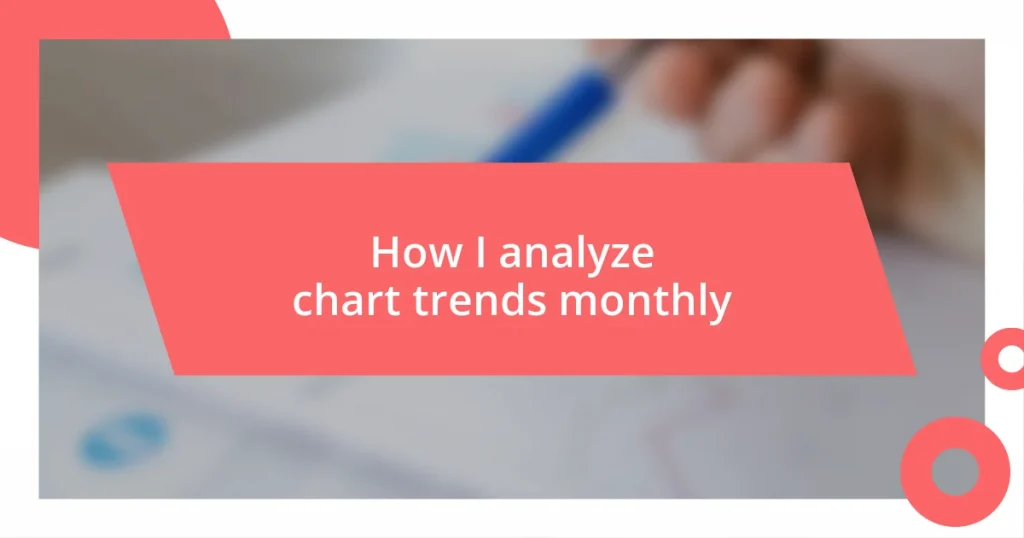Key takeaways:
- Understanding chart trends combines technical analysis with insights into market psychology, revealing emotions like fear and greed behind price movements.
- Regular monthly analysis enables the identification of long-term patterns, adjustments to strategies, and reduced emotional decision-making, enhancing forecasting skills.
- Effective data gathering and interpretation require reliable sources, structured routines, and flexibility in understanding market dynamics, allowing for informed strategy adjustments.
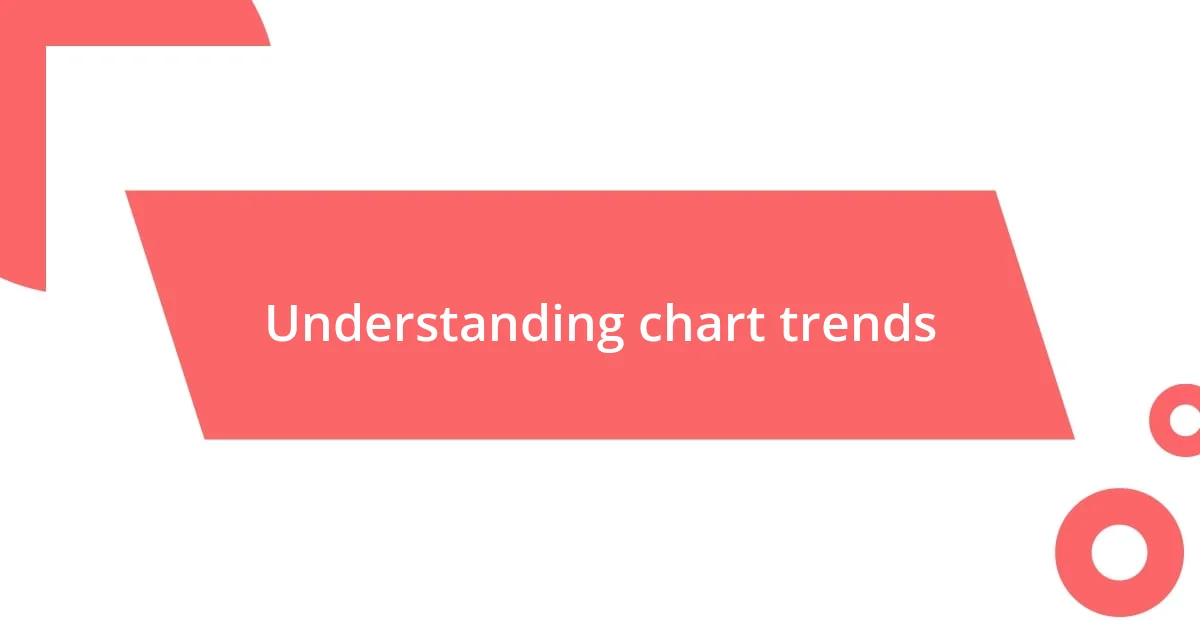
Understanding chart trends
Understanding chart trends is like piecing together a visual puzzle. I remember the first time I examined a stock market chart; it felt overwhelming. Yet, I soon realized that each peak and trough tells a story about market behavior and sentiment, giving valuable insights into potential future movements.
When I look at a chart, I often ask myself, “What emotions are driving these trends?” It’s fascinating how fear and greed manifest visibly through price fluctuations. For instance, during a market downturn, I’ve observed how anxiety ripples through the charts, creating sharp declines that can make anyone second-guess their strategy.
Every time I analyze a trend, I feel a mix of excitement and curiosity. Each trend isn’t just a movement; it’s a reflection of collective human decisions and emotions. Recognizing this connection makes chart reading not only a technical skill but also an art form that captures the essence of market psychology.
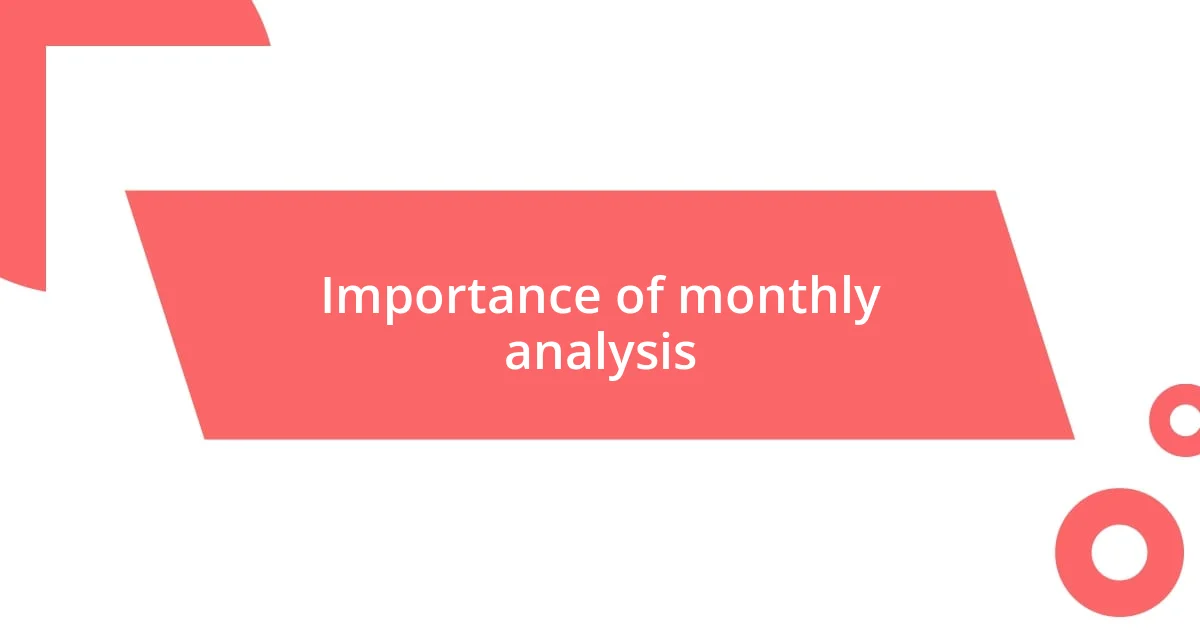
Importance of monthly analysis
Engaging in monthly analysis significantly enhances my understanding of trends and patterns. I’ve found that dedicating time each month to analyze data helps in recognizing shifts that might go unnoticed in day-to-day observations. For example, in one instance, a subtle upward trend in sales over several months didn’t catch my eye right away. But once I dug deeper during my monthly review, the potential for a bigger opportunity became increasingly clear.
Here are a few key reasons why monthly analysis is so important:
- Spotting long-term patterns: Monthly data reveals trends rather than fleeting movements.
- Adjusting strategies: Regular analysis allows for timely strategy modifications based on current data.
- Reducing emotional reactions: A structured approach minimizes impulsive decisions driven by daily fluctuations.
- Improving forecasting skills: Consistent analysis sharpens my ability to predict future trends accurately.
Taking this dedicated time has completely transformed how I perceive market dynamics. It’s an empowering experience to watch my insights grow each month, shaping my future decisions in more strategic ways.
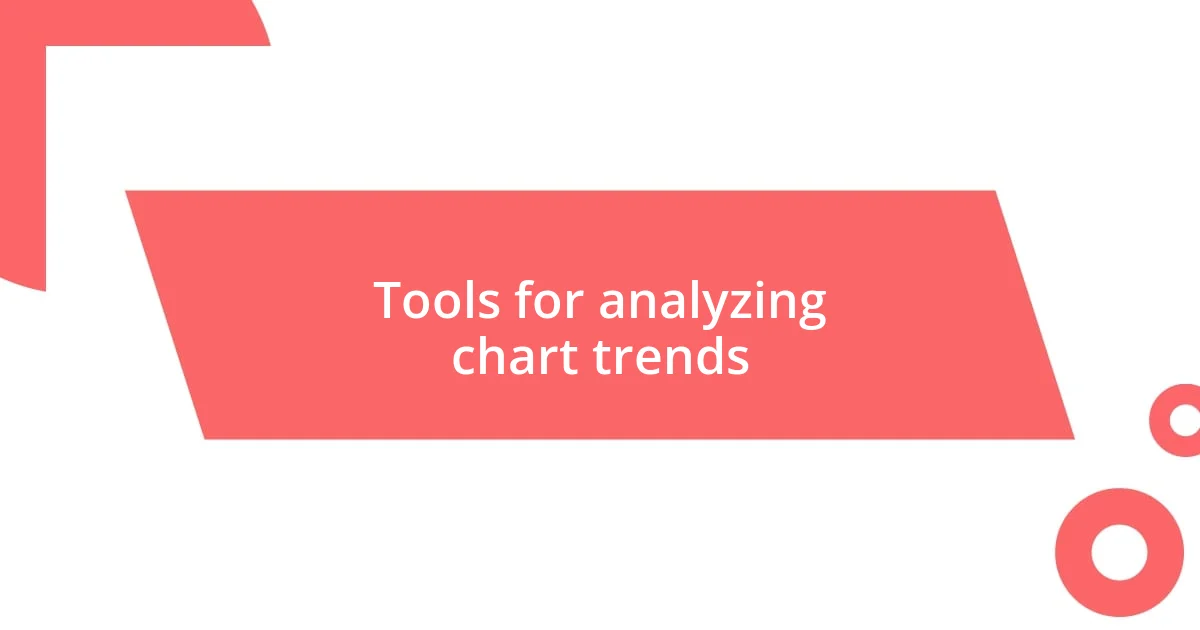
Tools for analyzing chart trends
Analyzing chart trends effectively requires the right tools at your disposal. Over the years, I’ve experimented with various software and platforms to streamline my analysis. One standout for me has been TradingView because of its user-friendly interface and robust community features. I still remember the sense of relief I felt when I discovered the customizable alerts feature, which enables me to stay updated without having to obsessively check charts throughout the day.
Another tool I frequently rely on is Excel. Initially, it might seem overly simplistic compared to dedicated charting software, but I’ve found that its flexibility allows for extensive data manipulation. For instance, I enjoy creating pivot tables that unravel insights from historical data. This has been particularly beneficial when I needed to present trends to my colleagues, as they appreciated the clarity in visuals generated from raw data.
Lastly, let’s not overlook the power of mobile apps like CoinStats or Yahoo Finance. While I love the depth of analysis available through desktop platforms, there’s something gratifying about checking in on trends during my morning coffee. I’ve often spotted surprising market shifts just while scrolling through my phone, prompting a quick adjustment to my trading strategy.
| Tool | Features |
|---|---|
| TradingView | User-friendly interface, customizable alerts, and community sharing |
| Excel | Data manipulation, pivot tables, and versatile visuals |
| Mobile Apps (e.g., CoinStats) | Real-time updates, easy access to trends on-the-go |
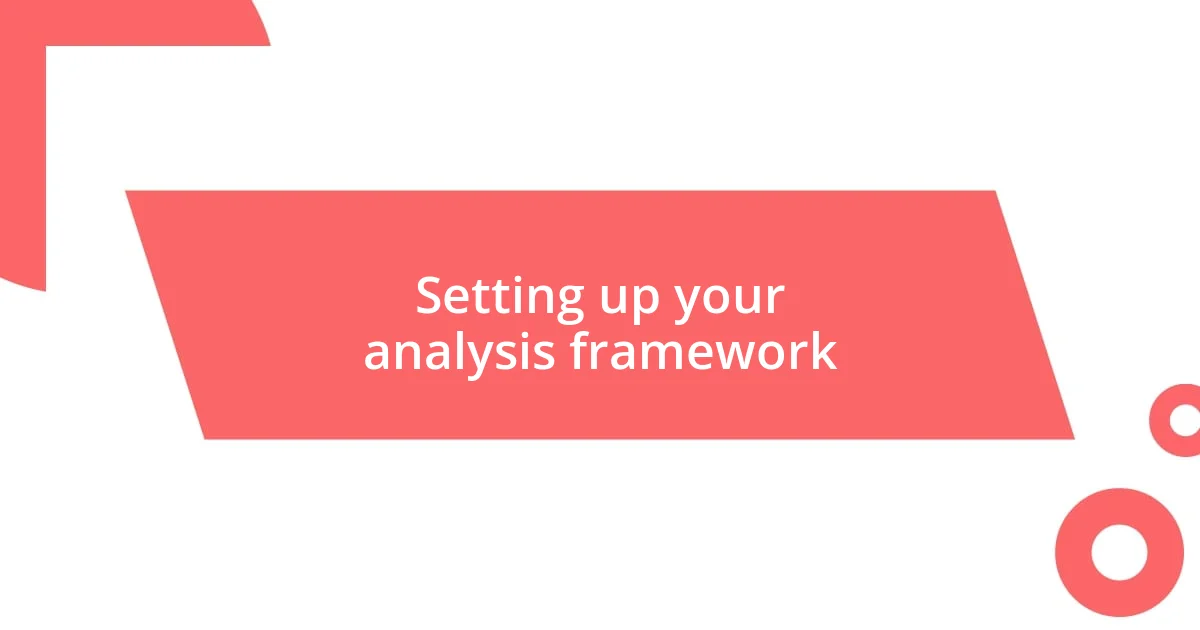
Setting up your analysis framework
Creating a solid analysis framework begins with defining clear objectives for your monthly reviews. I often ask myself, “What exactly do I want to learn from this data?” This question has guided me in honing my focus and preventing me from getting lost in the sea of numbers. Once my goals are set, I find it essential to establish consistent metrics that align with those objectives, ensuring my analysis remains relevant and actionable.
Another crucial step in this process involves organizing your data for easy access. I can’t tell you how many times I’ve felt overwhelmed by unstructured information. A little upfront effort in categorizing my charts and data sources can save countless hours later. By developing a systematic approach, like using designated folders or building a dashboard in my preferred software, I create an environment that promotes clarity. It feels rewarding when everything is at my fingertips; it allows for smoother analysis and insightful discoveries.
Lastly, I always stress the importance of a reflective mindset. As I analyze my charts each month, I often pause to think about how the data resonates with my past experiences. For instance, have I seen similar trends before? This introspective approach helps me draw connections and notice patterns that might otherwise go unnoticed. A framework that combines structured analysis with personal reflection empowers me to make well-informed, confidence-driven decisions going forward.
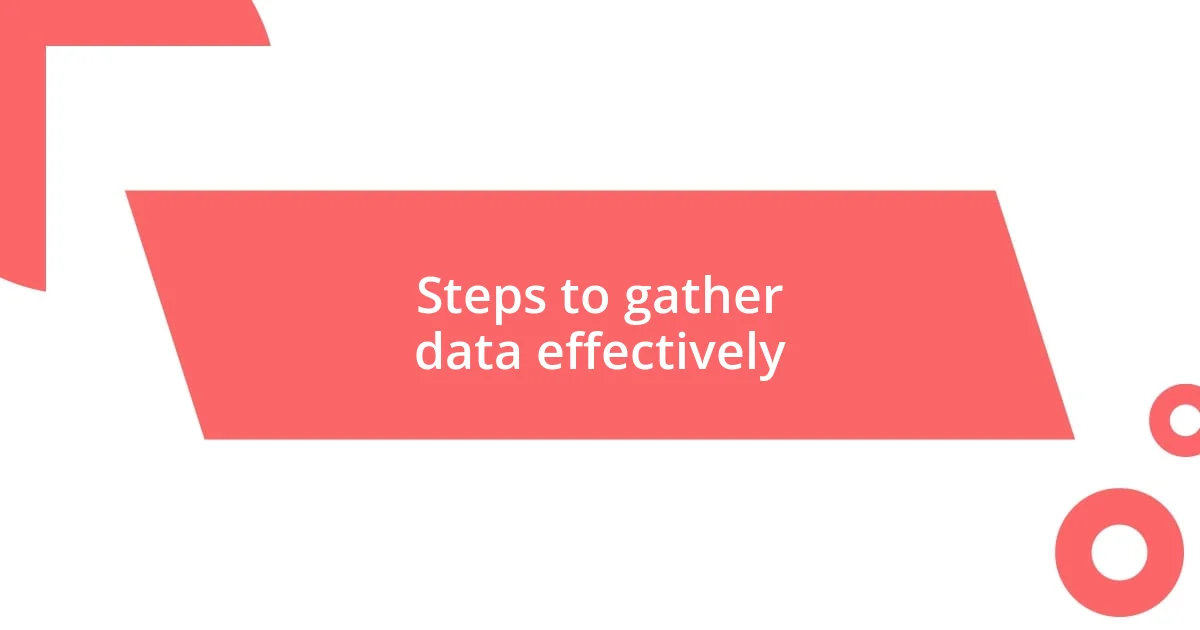
Steps to gather data effectively
When it comes to gathering data effectively, I always start by identifying reliable sources. It’s like laying the groundwork for a house; if the foundation is shaky, everything built on top can crumble. For me, websites like official financial news outlets and reputable market data providers have become the backbone of my research. I remember the early days of my analysis journey when I relied on some questionable blogs, which led me to make hasty decisions—learning the hard way really solidified the importance of trusting credible sources.
Another step I take is to establish a routine for collecting my data. I’ve found that consistency is critical; I set specific times each month to review and compile information. This habit ensures I’m never scrambling to gather everything at the last minute. It’s interesting how this disciplined approach has even started to feel comforting. There’s a sense of accomplishment in knowing I’m prepared and can approach my monthly analysis with the clarity that comes from well-organized data.
Lastly, don’t underestimate the benefits of documenting your findings. I maintain a journal of insights, observations, and even the emotional journey that accompanies each trend I analyze. During one such entry, I unexpectedly realized how a downturn I’d initially dreaded ended up presenting a golden opportunity. Reflecting on these moments not only aids in pattern recognition later but also offers me a sense of connection to my trading journey. Have you ever noticed how the act of writing things down can illuminate blind spots? I truly believe that this practice makes my analysis richer and more impactful.
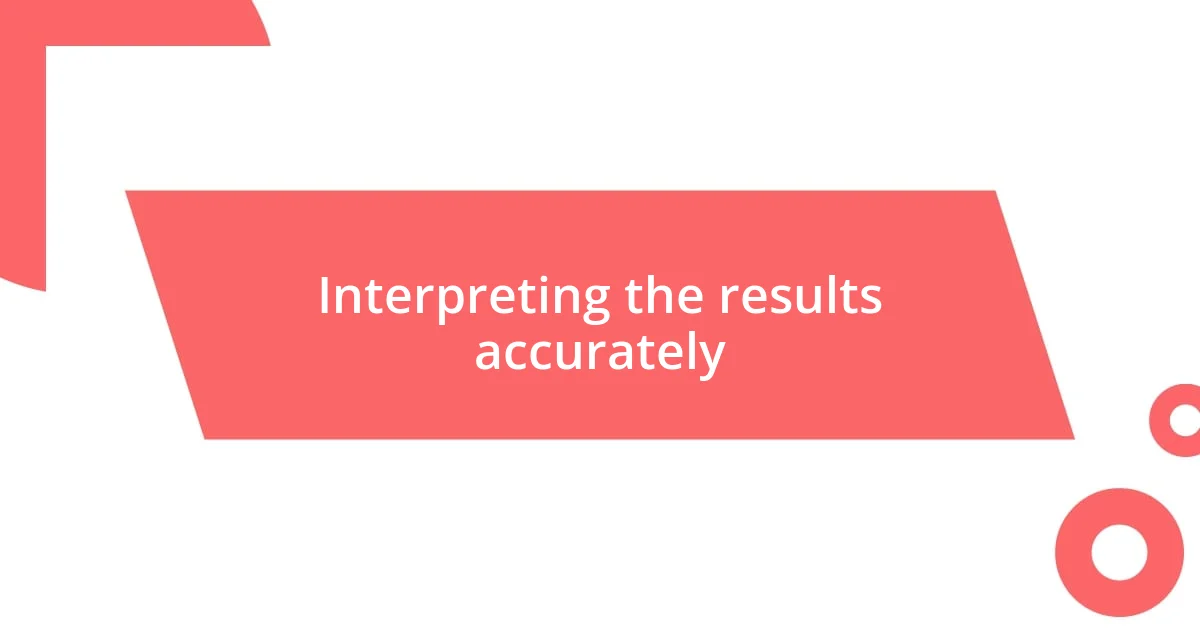
Interpreting the results accurately
Interpreting results accurately requires a keen eye for detail. I remember a time when I overlooked subtle fluctuations in a chart that, at the time, seemed insignificant. It wasn’t until I dug deeper that I discovered these fluctuations indicated a shift in market sentiment. This experience underscored the importance of examining not just the broad trends but also the small variations that can tell a more nuanced story.
Another essential aspect is understanding context. When evaluating results, I often remind myself of the external factors that could influence the data. For instance, during a global event like a pandemic, I analyzed how shifts in consumer behavior impacted my charts. By considering this context, I could interpret the results with greater accuracy, making my analysis not just data-driven but also grounded in real-world dynamics.
Finally, I find it critical to remain flexible in my interpretations. One month, I was convinced that a rising trend meant optimism, only to reverse that stance as I observed further data that indicated potential risks. This adaptability keeps my analysis credible and relevant. Have you ever clung to a conclusion only to realize later that it might not hold water? Embracing the fluid nature of data helps me stay grounded in reality while still pursuing insights.
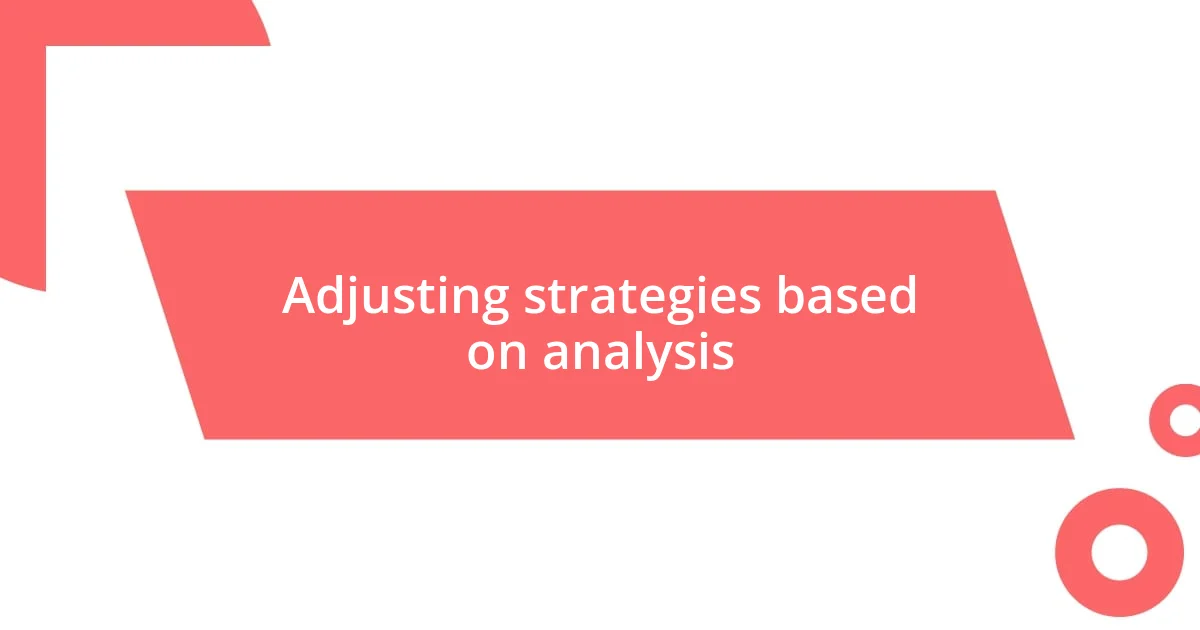
Adjusting strategies based on analysis
When it comes to adjusting strategies based on my analysis, I always feel a rush of excitement mixed with a hint of apprehension. I remember a specific instance where, after noticing a persistent downtrend in a sector, I decided to pivot my investment strategy. Rather than doubling down on my losses, I shifted my focus to emerging markets, which ultimately set me on a path toward recovery. Have you ever had to make such a leap? It can be daunting, but it often leads to unexpected opportunities.
The emotional component of strategy adjustment is profound. I once found myself reluctant to sell a stock that my gut told me was weakening. It was almost like a breakup—I had grown attached to it. However, after extensive analysis revealed clearer downward trends, I made the tough call to sell. The liberation I felt afterward freed me to invest in a much more promising venture. Isn’t it fascinating how emotions can cloud judgment, and yet, stepping back often sheds light on the better path?
Moreover, I believe it’s essential to regularly revisit past analyses to refine future strategies. Last quarter, I looked back at a time when I hesitated to adapt my approach due to inertia. Reflecting on that experience pushed me to draft a new set of guidelines for my trading—one that emphasizes not just adaptation, but also learning from my past mistakes. This iterative process becomes a beacon that illuminates my journey. Have you ever found yourself revisiting an old analysis and discovering nuggets of wisdom? Each experience adds depth to our understanding, shaping our future strategies in ways we might not initially anticipate.










